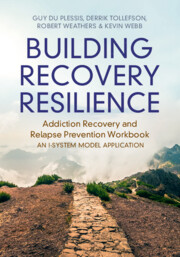 Building Recovery Resilience
Building Recovery Resilience Book contents
- Building Recovery Resilience
- Building Recovery Resilience
- Copyright page
- Contents
- Introduction
- 1 Dealing Effectively with High-Risk Situations
- 2 Coping with Cravings and Triggers
- 3 You Can’t Fix What’s Not Broken
- 4 Break the Addiction Cycle
- 5 The Requirements That Bind Us
- 6 Your Recovery Resilience Practice
- References
- Notes
- Index
6 - Your Recovery Resilience Practice
Published online by Cambridge University Press: 28 May 2024
- Building Recovery Resilience
- Building Recovery Resilience
- Copyright page
- Contents
- Introduction
- 1 Dealing Effectively with High-Risk Situations
- 2 Coping with Cravings and Triggers
- 3 You Can’t Fix What’s Not Broken
- 4 Break the Addiction Cycle
- 5 The Requirements That Bind Us
- 6 Your Recovery Resilience Practice
- References
- Notes
- Index
Summary
In the last chapter the authors provide an overview of all aspects of a Recovery Resilience Practice that will contribute towards a sustainable recovery-oriented lifestyle. In this chapter the reader will consolidate their Recovery Resilience Practice and see how to use it to support any recovery program or pathway. As highlighted throughout the workbook, the central aim of a Recovery Resilience Practice is to remove the hindrance that obstructs one’s capacity to access Recovery Capital and apply recovery skills as well as provide a practice that can help one deal moment by moment with stress, high-risk situation, triggers, or any troubling situations. In short, a Recovery Resilience Practice removes the hindrance to one’s innate resilience and capacity for flourishing and assists in achieving recovery and life goals. The last chapter provides an overview of how the workbook assists individuals in recovery to have greater self-awareness of their unhealthy and healthy coping styles and prompts them to evolve to a place of greater self-awareness so that they can make more informed decisions about their lives and efficaciously deal with life’s challenges.
Keywords
- Type
- Chapter
- Information
- Building Recovery ResilienceAddiction Recovery and Relapse Prevention Workbook – An I-System Model Application, pp. 160 - 186Publisher: Cambridge University PressPrint publication year: 2024
